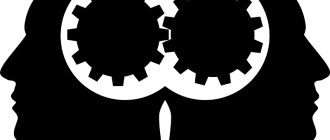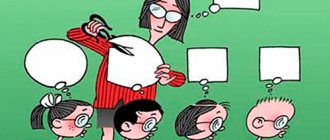Thinking is the conscious perception of the surrounding world in all its manifestations, the creation of ideas about objects and phenomena, the search for connections and solutions to problems, as well as the ability to abstract.
The main characteristic features of thinking:
- we perceive the world mediocrely, our knowledge of new objects and phenomena is formed through information already familiar to us;
- in the process of thinking, we always define a new object or phenomenon through its general and specific characteristics in relation to other objects known to us.
The purpose of human thinking is to comprehend the information received, recognize deep connections and properties of objects and phenomena, track their cause-and-effect relationships, find solutions to problems and generate new ideas.
By its nature, human thinking is cause-and-effect - throughout life, we consciously and unconsciously create models of situations that give us the feeling that we understand how something happens. Thinking is closely interconnected with the functions of memory - we not only remember many things, phenomena and events, but thanks to the process of comprehension we can analyze, abstract and create new meanings in the process of cognition. Despite the many limitations of nature and the shortcomings of causal thinking, which Stephen Sloman and Philip Fernbach talk about in their book The Knowledge Illusion, this type of thinking is considered the basic cognitive ability of humans. [Stephen Sloman, Philip Fernbach, The Illusion of Knowledge, 2017].
Of course, in most cases in life we think in cause-and-effect patterns, however, in order to effectively understand the world around us and function in it, we can and should develop other types of thinking, and we will talk about them in our article.
How does thinking work?
The main tasks of human thinking are not only the perception of a complex and multifaceted reality, but also its interpretation, understanding the depth and interconnections of different processes.
In most cases, in the process of thinking, we use the following logical operations to work with information:
- analysis;
- synthesis;
- abstraction;
- comparison;
- classification;
- generalization.
This or that thought process helps us comprehend new information, compare it with the facts we know, and thereby obtain new knowledge. Thus, when carrying out a mental operation, we resort to three basic forms of thinking: concept, judgment and inference.
Phases of mental activity
Thinking represents an action that is aimed at solving a problem. Action is a process, like any process it has certain phases in its structure. The thought process consists of the following phases:
- problem occurs
- formation of an approximate solution
- mental verification of this decision (by analysis, comparison, etc.)
- conclusion
The first phase of the thought process is the emergence of a problem, sometimes it causes surprise. When a person experiences difficulty in resolving some issue, this is the phase of the problem arising. Next, the individual realizes the presence of a problem and begins mental operations aimed at finding a solution. A person analyzes each approximately suitable solution and tests the hypothesis. After this, the person makes a conclusion as to which solution is most suitable. Problem solving is the final stage of the thinking process.
Types or degrees of development of thinking
Thinking as a form of knowledge of reality is studied today by scientists from various fields of science - psychology, philosophy, cognitive science, logic, pedagogy and computer programming. Despite different approaches and interests, all of these directions are of the opinion that human thinking consists of three types or stages of cognitive development:
- Subject-real thinking is the direct perception of an object.
- Visual-figurative thinking is the ability to operate with images in the mind and remember an object.
- Abstract or verbal-logical thinking is the ability to perform logical operations with concepts in the mind.
All these types of thinking are inherent in every person and develop in the process of growing up and learning.
A few words about the concept
If we rely on the definition that Wikipedia gives us, then thinking is the mental process of modeling the laws of the surrounding world on the basis of axiomatic provisions.
The term has many simpler definitions.
Thinking is a human cognitive activity, the result of which is a thought in the form of an idea, meaning or concept.
In neuropsychology, thinking is considered one of the highest mental functions, which has a motive, a goal, a system of actions and control.
This phenomenon began to be studied back in ancient times. Philosophers and scientists considered it not from the point of view of psychology, but from the position of philosophy and logic. Many philosophers called thinking an essential property of man. This is clearly demonstrated by Descartes’ famous saying: “I think, therefore I exist.”
This process is related to the functioning of the brain. However, a person’s ability to think in one way or another arises in the process of life experience, culture, norms of language, logic and other factors.
The stages of development of thinking can be seen in the table.
Fast and slow thinking
First of all, I would like to start with a fundamental understanding of how we think, or more precisely, with what modes of thinking each person has. Nobel laureate and cognitive psychologist Daniel Kahneman formulated a theory of how we perceive the world around us and make our own decisions using two modes of thinking - fast and slow.
Rapid, heuristic thinking, or System I, is unconscious decision making that occurs based on life experiences, instinctual and intuitive impulses. This type of thinking works automatically. But such a decision-making mode will not always lead to the right choice. Typically, a person's heuristic thinking is largely influenced by emotions, unconscious stereotypes, prejudices and biases.
On the other hand, every person possesses slow, rational thinking or System II. Unlike heuristic thinking, Daniel Kahneman calls rational thinking lazy and requiring special focus and mental effort. And it is this part that is responsible for our critical thinking. Its main rule is to take your time and analyze any information, consciously weed out possible cognitive distortions and biases. Scientists usually include the most common cognitive distortions:
- affective heuristics - the use of a simplified decision-making scheme based on a strong emotional reaction;
- availability heuristic - assessing the importance of a factor based on how easily you remember something;
- The recency effect is a bias that causes us to overestimate the significance of events because the image is fresh in our memory;
- the focus effect is that due to excessive attention to one aspect, we underestimate the importance of other relevant factors;
- stereotypes are a persistent and unconscious idea of a subject, always one-sided and simplified;
- The framing effect is the presentation of the same information from different angles with the deliberate goal of evoking positive or negative emotions.
Thus, any situation can be perceived using both fast and slow thinking. It all depends on how much you are ready to “turn on” your rationality [Daniel Kahneman, “Thinking Slowly, Decide Fast”, 2014].
Disorders
Thought disorders are disorders of mental activity. Violation is divided into quantitative and qualitative.
Quantitative forms of the disorder are characterized by speech impairment, delayed neuropsychological development, or mental retardation.
Forms of quantitative disorder:
- Mental retardation (MDD) is diagnosed in children 2-3 years old. Treatment is prescribed by a neurologist.
- Oligophrenia (mental retardation is characterized by impaired development of a child from an early age). A child with oligophrenia is observed by a neurologist and psychotherapist. The goal of treatment will be socialization and learning self-care.
- Dementia is a disorder of mental processes that manifests itself in adulthood or adolescence. Observation by a psychotherapist.
The speed of thinking depends on the predominance of processes in the cerebral cortex. This may be excessive excitement or, on the contrary, inhibition of mental activity:
- Disruption is characterized by a rapid change of thought, in which speech becomes absurd, logic and consistency of judgments are completely absent. Speech consists of fragments of phrases quickly replacing each other. The grammar of speech is usually preserved. This disorder is inherent in schizophrenia.
- Manic syndrome is characterized by accelerated speech and a simultaneous increase in psycho-emotional background. Speech is accelerated, the patient can speak “excitedly”, especially pronounced in certain topics.
- Slowing down of mental processes is inherent in depressive syndrome. Distinctive features: absence of thoughts in the head, slow speech taking into account the slightest details that are not related to the essence of the issue, predominance of a depressed mood.
- Thoroughness is expressed in excessive “drowning” in details. The patient has difficulty switching from one question to another, and rigidity of thinking is observed. Circumstances are inherent in diseases of the nervous system (Epilepsy).
- Reasoning is revealed during long-term communication and is expressed by a tendency to teach. When a person does not answer the question posed, but talks about things that have nothing to do with him and strives to teach life to everyone with whom he begins to communicate.
- Autism develops in withdrawn people. A distinctive feature of this disorder will be isolation from the world, poor orientation in society and immersion in internal experiences, which often do not correspond to the real state of affairs.
- Obsessive syndrome is characterized by obsession with ideas or thoughts that the patient cannot get rid of, although he understands the absurdity. Obsessive thoughts depress a person, cause negative emotions, make them suffer, but the patient cannot cope with them. They arise against the background of persistent excitation of a part of the nervous system.
- Phobias (unreasonable fear) . Various phobias arise against the background of overexertion and performing a difficult task for an adult or child. In childhood, fear of punishment gives rise to various phobias.
- Extremely valuable ideas arise in adolescence. The predominance of a brightly colored emotional background indicates the development of this syndrome. This disturbance of consciousness does not cause suffering to the patient.
- Delusional thinking (often accompanied by hallucinosis) is characterized by the emergence of persistent thoughts of ideas that cannot be convinced. Inference is based on a logical conclusion made on the basis of some data. This could be fear of persecution, unreasonable jealousy, self-flagellation. Delusional thinking can be dangerous for others and the patient with a pronounced syndrome. Treatment by a psychotherapist or psychiatrist is required.
Pathology of thinking often provokes disturbances in the emotional background (depression, euphoria, apathy). Any disturbance in the thought process should be observed by a specialist. If necessary, psychocorrection or drug therapy is carried out. Ignoring the pathology of thinking can lead to persistent mental pathology and cause serious problems for societies or the patient.
Diagnosis of thinking involves determining the type of excitation of brain activity and the characteristics of thought processes. The ability to solve current problems is also taken into account. The development of speech and thinking is closely related and begins at an early age.
When speech development is delayed, mental activity is also impaired. It is important to notice the deviation in time and begin training thinking, using available methods of developing thinking (game, action, training).
Logical and analytical thinking
Logical thinking is the basic human ability to prove something. It is thanks to this type of thinking that we can form our observations into a clear system of understanding knowledge about the world. The basic tools of logical thinking are:
- deduction;
- induction (or developmental thinking);
- abduction;
- associations.
Moreover, all reasoning must comply with the four laws of logic, three of which belong to Aristotle, and one to Gottfried Leibniz.
Although in his time Aristotle valued logical operations above all else, in the modern world logical thinking alone is not enough. An equally important thinking skill is analytical thinking—the ability to interpret, find patterns, and make decisions based on available information.
You can learn more about logical thinking and learn how to develop it by taking our course “Logical Thinking,” and we have a good article devoted to analytical thinking, “What is Analytical Thinking and How to Develop It.”
In what cases is there a violation of normal cognitive abilities and can this be corrected?
Abstract thinking is a typical feature of the human personality and psyche. It does not develop in one moment. It takes some time. Usually, abilities are fully formed by adolescence; there may be variants with delayed development or early development. The development of abstract thinking in a person ends by the age of 15-16 years. In psychology and neuropsychology there are some discrepancies on this issue, but they are not significant. Deviations should be considered as a potential symptom of psychopathology.
Impairment of abstract thinking can be the result of congenital pathologies of the genetic profile of the central nervous system. These include oligophrenia in different types, Down syndrome. These are the main diagnoses. There are others too. They are united by pronounced dementia and lack of ability for logical thinking. In almost 100% of cases, other forms of mental activity are also affected. There is a drop in IQ to critically low levels. With a mild degree of mental retardation or debility, it is possible to perform simple operations. With sufficient compensation, changes are minimal.
Abstract, abstract thinking is a target in schizophrenia. Especially malignant or long-term. Intelligence formally remains at a normal level, but the patient is unable to use the tools, so a semblance of dementia begins. This is a type of defect, the so-called negative symptoms. Typically, such conditions are not subject to reverse development or any correction. However, modern psychotropic drugs have the ability to combat the negative manifestations of the pathological process.
There are diagnoses in which the disorders are temporary. Although they can be significantly expressed. These include, for example, depressive states, manic-depressive psychoses, and reactive psychoses.
The speed of abstract thinking decreases when using alcohol or taking drugs. Or mental abilities are seriously weakened.
There may be several options. The issue of diagnosis is no longer the sphere of psychology. The problem is solved by psychiatrists, psychotherapists, and in some cases neurologists in tandem with mental health specialists.
It is not always possible to cope with these problems. It all depends on the diagnosis. The highest quality correction is carried out when eliminating depression, alcohol disorders, and the consequences of drug use.
Critical and non-critical thinking
Uncritical thinking is taking everything you hear and see on faith. In this case, the person does not think about the reliability of the information, the importance of what is perceived and its purpose. It is this inability to read between the lines that is the main reason for phishing or manipulating people.
In contrast to an uncritical perception of the world and excessive trust, critical thinking is a person’s ability to make sense of everything around him. A well-developed ability to think critically allows a person to avoid becoming a victim of rhetoric, manipulation and misinformation. Contemporary British philosopher Tom Chatfield calls critical thinking a metacognitive skill that allows:
- quickly learn, improve and adapt;
- treat information selectively and carefully and be able to verify it;
- explain your point of view clearly and logically;
- understand your interlocutor better;
- control emotions;
- selectively work with information flows;
- notice and not fall under the influence of patterns and stereotypes;
- comprehensively comprehend what is happening.
Thus, the goal of critical thinking is to find the best explanation for everything that happens in the world. To be as critical as possible, you need to remember these important aspects of cognitive cognition:
- healthy skepticism;
- objectivity;
- awareness of bias;
- elimination of cognitive distortions;
- use of logical thinking.
Tom Chatfield also formulated 10 commandments of critical thinking:
- Take your time and think about the information.
- Save your mental strength. Willpower, energy and attention are very limited resources.
- If in doubt, you need to wait.
- Realize your own limitations.
- Be aware of sunk costs and weigh whether to make them.
- Evaluate strategy, not results. This will help minimize risks in long-term plans.
- Remember reversion to the mean. We all vividly remember either successful or bad results, and at the same time we forget that the number of ordinary, mediocre results in life situations outweighs the ups and downs.
- Look not for confirmation, but for refutation. Your arguments will be much more convincing if they are not only confirmed many times, but also if you include contradictions and justify their inconsistency.
- Know your frame of reference, values and level of endurance.
- All suggested options may be wrong.
The ability to think critically will help you not only better express your own thoughts, but also not become a victim of clip thinking due to an excess of information on the Internet [Tom Chatfield, “Critical Thinking”, 2019]. And our “Critical Thinking” course, which we strongly recommend that you take, will help you develop your critical thinking to a high level.
Scientific thinking
In addition to the ability to think in everyday life, which we acquire in the process of social communication and life experience, there is also scientific thinking - a special way of understanding the world and interpreting reality.
In scientific thinking, unlike everyday thinking, there is a strict algorithm for collecting, systematizing and checking information with subsequent stages of processing it in order to obtain new knowledge about the subject. For scientific thinking, it is important to minimize the level of subjective interest, personal determinism, to use different forms of analysis, theoretical justification of the problem and methods of achieving the goal. Another important characteristic of scientific thinking is solving a problem or rethinking existing knowledge.
You can read more about the important aspects and specifics of scientific thinking in the article “Scientific thinking: meaning, features and methods.”
Let's sum it up
The importance of thinking in a person’s life for the formation of a successful personality is enormous.
Without it, no individual will be able to benefit from the knowledge he needs. Conversely, the maximum benefit even from a minimum of information can be obtained with sufficiently developed mental activity. Human nature is unique. We are a fairly young species of living beings that were able to rise to the top of the food chain on planet Earth. Only by developing intellectually will we be able to conquer new limits of reach and achieve success. Go for it!
This concludes the story. See you soon. Bye!
Types of thinking in a global perspective
In the modern world, more and more scientists, philosophers and writers are trying to set new boundaries for society - how to develop in the period of globalization, perceive all kinds of information flows and keep up with progress. Cognitive psychology professor Howard Gardner, known for his theory of multiple intelligences and new forms of learning, is confident that our time requires new and positive types of thinking that will be important not only for the individual, but also for society.
Gartner refers the first three types of thinking as forms of cognition, and the last two to the area of human relationships:
- Disciplinary type of thinking. Once we have mastered this mindset, any of us can call ourselves an expert in any discipline, craft or profession. Howard Gardner argues that in the modern world, many people neglect the quality of their professionalism and do not realize the scale of their chosen profession or calling. Besides the fact that learning any craft takes on average up to 10 years, the process of improving skills must last a lifetime, and we must follow technological and innovative changes. Thus, people who have not mastered at least one discipline will not be able to be successful in the future.
- Synthesizing type of thinking. It helps not to drown in the flow of information, skillfully systematize it, highlight features and see trends. This thinking skill is very useful not only for executives, managers and analysts, but also for creative people who strive to change the world around them. And if you do not master the synthesizing type of thinking, a person will drown under an endless stream of information and it will be very difficult for him to make important decisions, both career and personal.
- Creative type of thinking. According to Howard Gardner, it organically complements the previous ones. A person who has well-developed creative thinking, having good knowledge in several fields and areas of life, can develop original ideas that will change society. Creativity is especially important in the modern world, because computers are completely replacing human labor in many areas of service and office work.
- Respectological type of thinking. Helps you wisely form your own boundaries with the outside world, respect and appreciate the differences between people and groups. By learning this type of thinking, a person stops blindly believing stereotypes and other cognitive distortions that are often adopted unconsciously. A person with a good respectability mindset is able to accept people for who they are, respect them, and not judge or underestimate them because of cultural, racial, or other differences. It is by respecting other people that we are aware of the positive climate around us and contribute to a good work process. Gardner is confident that a person's true respect for others is manifested in ordinary life situations, when no one is watching the person. A person who has developed respectological thinking tries to positively evaluate everyone, without taking into account social characteristics and biases, and he is always ready to admit his guilt and change his decision if he receives new information.
- Ethical type of thinking. Refers to a higher worldview, having mastered which, a person can not only reflect on the desires, needs and trends in society, but also influence the course of events in a reasoned and authoritative manner. The concept of this type of reasoning is much broader than respectological thinking, which is based on the idea of tolerance and respect. The ethical type of thinking is a view from above, which helps to evaluate the actions of each person from the point of view of usefulness for society. Thus, by developing ethical thinking, we develop civil society. But Howard Gardner reminds us that an important aspect of ethical thinking is that there is no universal ethics - you always need to start from the context, history and cultural memory of each society.
All types of thinking proposed by Gardner are not separate mental abilities, but rather represent a complex of a comprehensively developed person who feels his importance and social duty. This is why Gardner suggests developing all types of thinking from as early an age as possible, although he does not discount the possibility of teaching these abilities to adults [Howard Gardner, “Thinking for the Future,” 2015].
What are mental processes and what are they like?
Definition 1
Mental processes are mental phenomena that perform their specific functions in the integral system of the human psyche.
The emergence of this concept dates back to the late 19th and early 20th centuries, when analytical views played a leading role in science. Today, modern scientists believe that mental processes should not be considered individually, since they are all interconnected and cannot exist separately.
There are three main groups of mental processes:
- cognitive (sensation, perception, reflection, speech, attention, representation, thinking, memory, imagination)
- emotional (emotions, feelings, affects, stress)
- strong-willed (struggle of motives, decision-making, goal setting)
Are you an expert in this subject area? We invite you to become the author of the Directory Working Conditions
Further in the article we will talk in more detail about such a cognitive psychological process as thinking.
Creative thinking
Creative thinking is also commonly called creative thinking. The main goal of this approach to thinking is to generate ideas and create new discoveries. Its peculiarity is that to activate creativity, you need to use not only the left part of the brain, responsible for logical-verbal images, but also the right hemisphere, the creative one.
Creativity expert Michael Micalko argues that it is impossible to create anything new if you use only what you already know about something. He believes the secret to all new and exciting ideas is conceptual mixing.
Conceptual blending is a creative thinking process in which two or more concepts are mixed to invent a new one, and preference is given to imagination rather than logical thinking while working. This way of thinking was characteristic of many geniuses of the past: Isaac Newton, Wolfgang Mozart, Sigmund Freud, Van Gogh, Pablo Picasso. All these people were not afraid to go beyond the accepted thinking and break the rules. Leonardo da Vinci called this mental strategy of multiple observation perspectives “saper vedere” or “the ability to see,” and Albert Einstein called it a combinatorial game.
Mikalko is convinced that we are often prevented from coming up with something new by generally accepted thinking models (or linear thinking), which we perceive unconsciously during our schooling. But he is also confident that everyone can develop creativity [Michael Mikalko, “Creative Explosion”, 2013]. By the way, on the topic of developing creative thinking, we have a good course “Creative Thinking: Development of Creativity.” We advise you to get to know him.
Is it possible to develop abstract thinking, how and how long will it take?
How to develop abstract thinking and is it even possible to do this? Yes, you can. Methods exist. However, this is not a quick process. According to various estimates, it will take from several months to a year to achieve high-quality results. It is easiest to develop such abilities in adults. Children don’t have much sense; you need to wait for the final formation of logical abilities and only then start. That is, during the teenage years. Techniques:
- Oral exercises. Reasoning on specific topics with conclusions and others. They also allow you to develop a verbal style of mental activity.
- Solving logical problems. As much as possible. Preferably with a gradual increase in complexity and a clear description of the process of thinking. Guesswork and simple coincidences must be excluded.
- Writing essays on specific topics. Expressing arguments for, against, one’s own position and conclusions on the issue. This allows you to develop not only abstract, but also critical thinking.
Visual thinking
Visual thinking is another type of creative thinking that will be useful in many life situations. Visual thinking will help:
- create the perfect travel plan or route;
- solve the problem of;
- structure information.
It also helps in organizing projects and any events and allows you to figuratively explain the essence of new ideas.
The main feature of visual thinking is its impact on people’s visual and figurative perception rather than on the verbal and abstract [Roem Dan, “Visual Thinking: How to Sell Your Ideas Using Visual Images,” 2013].
The most famous form of visual thinking was developed by British psychologist Tony Buzan, which he called mind-maps.
The essence of using mind maps is to successfully memorize a large amount of information, generate different options for solving problems and the ability to see key ideas in information flows. The effectiveness of this technique lies in the use of figurative rather than linear thinking.
Tony Buzan calls this way of generating ideas radial thinking, which is based on the use of associative logic, focusing on details and seeing the future. The mind map itself has a tree-like structure and provides for the gradual development of a hierarchy of information importance [Tony Buzan, “Mind maps. The Complete Guide to Powerful Intelligence", 2018].
To delve deeper into the essence of using mental maps, be sure to read our article “How you can use mental maps” and, of course, the book by the creator of these maps, Tony Buzan, “Mind Maps”.
Design Thinking
Design thinking is considered less creative, but no less effective. Its main principle is the step-by-step structuring of information, consideration of possible prospects for the development of the problem in order to predict the best option. The main difference between design thinking and traditional analytical thinking is the combination of creative and analytical approaches.
Stages of design thinking:
- Clearly define the problem, study the opinions of other people.
- Explore the characteristic patterns and features of the problem.
- Generate ideas and principles for solving a problem.
- Creating a draft is the first option for solving the problem.
- Evaluate the results.
- Improve the plan for solving the problem, add new methods.
Thus, the main tools of design thinking are logic, imagination and intuition. This approach helps to correctly understand and set priorities, as well as rethink some beliefs that prevent you from achieving what you want [Bill Burnett, Dave Evans, “Designing your life. Live the way you need”, 2018].
If you want to understand design thinking better, we have for you the articles “What is design thinking” and “Design thinking: what is it and how to apply it”, as well as a very interesting course on design thinking, which you can take you will learn to apply many interesting techniques and techniques in any area of your life.
Joy Paul Guilford's Theories of Creativity
Psychologist Joy Paul Guilford is known as the developer of two models of thinking and concepts of creativity. He identified four main principles of creative solutions:
- originality – producing new ideas using associative thinking;
- semantic flexibility - the ability to determine the characteristics of an object or phenomenon, develop new alternatives to properties, improve ideas;
- figurative adaptive flexibility - the ability to change the shape, characteristics or capabilities of an object;
- semantic spontaneous flexibility - the ability to produce ideas in limited time and urgent situations.
Also, Joy Paul Guilford describes two creative systems of thinking: convergent and divergent.
Divergent thinking is characterized by seeing several options for solving a problem using the same initial data. The development of divergent thinking is based on the use of imagination within clearly defined parameters (for example, you need to come up with as many ways as possible to use different objects).
Convergent thinking allows you to find a single correct solution among a large amount of information. The main approach to applying this type of thinking is to use previously learned strategies and algorithms to solve problems. Thus, divergent thinking is inherently considered a more creative type of cognition.
You can read more about the development of divergent and convergent thinking in our article “Divergent thinking: features, methods of development.”
Systems thinking
Systems thinking helps to see the relationships between objects and phenomena, understand the context, correlation and causation of events.
Systems thinking is usually used to effectively solve problems. The essence of this thinking is that in order to understand how to solve a problem, you need not only to understand the problem itself, as a consequence, but to understand what led to its occurrence, what phenomena and factors caused its occurrence. This approach to solving the problem is that systems thinking develops nonlinearly, but in many directions simultaneously [Donella Meadows, “The ABCs of Systems Thinking,” 2018].
The strength of systems thinking is that it helps to go beyond linearity and formal logic, to see subtle relationships between objects and phenomena. That is why systems thinking is a more reliable tool for finding the cause of a particular problem than the cause-and-effect thinking that is typical for all people. You just need to learn how to use it. Systems thinking allows you to see the algorithms of relationships and the structure of any object or phenomenon more reliably [Ian McDermott, Joseph O'Connor, “The Art of Systems Thinking”, 2018].
Development (exercises for training)
The development of thinking begins at an early age. At birth, the baby does not have the ability to think, but by the age of one year the beginning of thought processes is formed. To develop thinking, knowledge, experience, and memory are necessary. In the process of development, the child accumulates the necessary components through knowledge of the world around him and the simplest thinking begins to manifest itself.
The speed and quality of the formation of thought processes depends on how much attention parents pay to this issue. It is necessary to constantly work with the child to quickly develop and consolidate thinking skills.
The ability to form thoughts encourages self-learning and knowledge. The development of thinking occurs continuously from birth until complete extinction in the process of communication. Activities and learning new things in everyday life are shaped by a person’s subconscious. At each life stage it has its own characteristics:
- For young children, thinking is visual and effective. All processes aimed at performing the simplest tasks (taking a toy, opening a box, bringing something or getting something). The child thinks, acts, develops. This continuous process is learned in everyday life both through play and through the need to achieve certain actions.
- When mastering speech, the child learns to generalize and gradually his thought process goes beyond the visual and effective. Thinking and speech are in close connection; human speech contributes to the development of abstract thinking, the ability to generalize objects and phenomena, and to identify the essence based on acquired knowledge. Speech in adults is the main way of transferring experience and skills, which greatly facilitates learning.
- The expansion of speech allows one to express oneself in words; the child moves more towards figurative and abstract thinking. At this stage, fantasy is formed. Creative abilities develop.
- Schoolchildren learn to operate with knowledge acquired verbally (general education subjects). There is no practical confirmation by experience. This stage teaches you to draw conclusions based on logical connections and accumulated knowledge about objects and phenomena. Various school curriculum methods increase the efficiency and speed of operating with concepts and reaching conclusions in a short time in the presence of insufficient knowledge about a subject or phenomenon.
- Higher grades promote the formation of abstract thinking. Studying and analyzing fiction provokes the development of thinking and imagination.
The older the child gets, the more thinking methods are involved in the daily process. The main means of developing children's thinking is education, including the formation of speech, the study of objects and phenomena through verbal transmission of data and the formation of abstract thinking and imagination based on fiction, creativity (drawing, knitting, embroidery, wood carving).
The stages of development of thinking directly depend on what was learned earlier and the level of intelligence. Usually appropriate for age categories.
In the accumulation of a conceptual base, several levels are distinguished: the higher the level of development, the easier it is for a person to generalize or analyze phenomena (or objects), the easier it is to find a solution to the question:
- The first level is characterized by the ability to generalize simple concepts accumulated by personal experience or learned when presented in verbal form.
- The second phase is marked by the expansion of conceptual thinking.
- The third level is characterized by the ability to give clearer concepts of conditions, identify specific signs and support what has been said with specific examples from life that are suitable for the meaning and conditions of the task.
- The fourth level is the highest level of conceptual thinking, in which the individual has complete knowledge about an object or phenomenon and easily determines its position in the world around him, indicating the relationships and differences.
Important! The higher the level of knowledge of concepts, the clearer the judgment becomes and the easier the conclusion is reached.
Strategic and tactical thinking
Strategic thinking is a skill that allows you to achieve the desired result in the future. We are all strategists to one degree or another, as we make plans and envision how to achieve goals. But some people do not plan intuitively and cause-and-effect, based on experience, but possess important techniques and thinking tools. These are the people who are called strategists.
Strategists know how to behave now in order to get what they want later, even if it is unlikely, strategists will mentally calculate possible options for achieving the goal. This is how they build their tactics.
Therefore, tactical and strategic thinking are closely interrelated: strategy is long-term goals, and tactics are specific and understandable actions that should lead to the desired long-term goals. Strategy usually answers the question “What?”, and tactics usually answers the question “How?”.
Strategic thinking is more than being two steps ahead of the enemy, it is the ability to calculate not just one outcome of events, but several - be it paths to competition or cooperation. Therefore, due to the many possible options and the low percentage of implementation of each of them, economics professors and business coaches Barry Nalebuff and Avinash Dixit consider strategy more an art than a strict cognitive process, which is characterized by clear steps to achieve a goal [Barry J. Nalebuff, Avinash Dixit, Game Theory. The art of strategic thinking in business and life", 2018].
Thus, thinking strategically is not so much knowledge of the world as the ability to realize one’s thoughts and ideas even with low certainty. Knowledge of strategic principles helps you make decisions and act more effectively, become stronger and achieve an advantage. Strategic thinking helps develop memory, concentration and multi-vector analysis of any situation in life, business or politics.
To master this type of thinking, you can read our articles “How to Develop Strategic Thinking”, “Tips on How to Think Strategically”, “Seven Pillars of Strategic Thinking” and “How to Become a Strategic Genius”. And we summarize the article and want to give some more useful tips.
How to develop thinking
As you can understand from our article, thinking is a skill that can and should be constantly developed. To improve your analytical, creative and strategic abilities, you must first set clear goals for yourself. You will find useful tips on developing your thinking in our articles “How to change your thinking” and “Developing your thinking: ways to train your brain.”
Moreover, we have excellent courses to develop different types of thinking. In the “Cognitive Science” course, we have prepared more than 20 techniques that will teach you to reason effectively and logically, make quick decisions and find innovative solutions to various problems, and the “Neurosciences” program will improve your memory, visual thinking and ability to concentrate.
Also, be sure to pay attention to the programs, articles and courses to which we provided links, and below you will find links to materials used in writing the article - they may also be useful to you:
- Maria Falikman, “Types of thinking.”
- Roem Dan, “Visual Thinking: How to Sell Your Ideas with Visuals,” 2013.
- Barry Buzan, Superthinking. Change your life with mind maps", 2021.
- Bill Burnett, Dave Evans, Designing Your Life. Live the way you need”, 2021.
- Donella Meadows, The ABCs of Systems Thinking, 2021.
- Ian McDermott, Joseph O'Connor, The Art of Systems Thinking. Essential knowledge of systems and creative problem solving", 2021.
- Barry J. Nalebuff, Avinash Dixit, Game Theory. The art of strategic thinking in business and life", 2021.
- Pavel Avraamov, “Go Strategy. An ancient game and modern business, or how to win the competition", 2021.
- Stephen Sloman, Philip Fernbach, The Illusion of Knowledge. Why we never think alone,” 2021.
- Daniel Kahneman, Think Slow, Decide Fast, 2014.
- Tom Chatfield, Critical Thinking. Analyze, doubt, form your opinion”, 2021.
- Howard Gardner, Future Thinking. Five types of intelligence leading to success in life", 2015.
- Michael Mikalko, Creative Explosion, 2013.
- Tony Buzan, Mind Maps. The Complete Guide to Powerful Intelligence", 2021.
Good luck!
We also recommend reading:
- Storytelling
- Daniel Kahneman “Think Slowly... Decide Fast” - summary of the book
- How and why to develop thinking
- Thinking techniques
- Theories of thinking
- Combinatorial thinking
- Conceptual thinking: by stages of cognition
- Language and thinking
- Language and thinking: relationship and related issues
- Types of thinking
- Digest: critical thinking
Key words: 1LLL, 1Cognitive science











